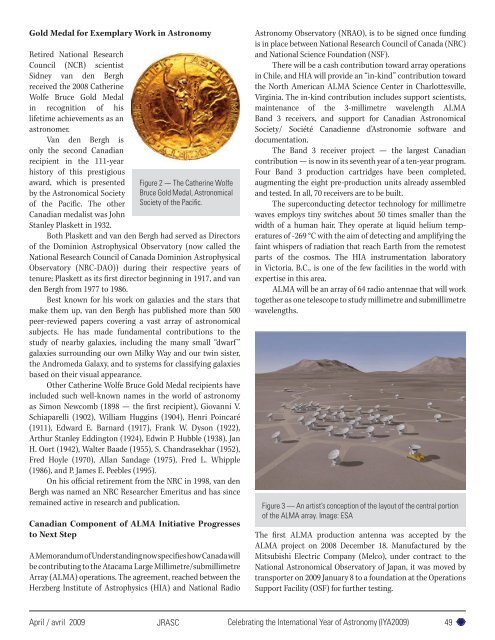Moment
insidethisissue - The Royal Astronomical Society of Canada
insidethisissue - The Royal Astronomical Society of Canada
You also want an ePaper? Increase the reach of your titles
YUMPU automatically turns print PDFs into web optimized ePapers that Google loves.
Gold Medal for Exemplary Work in AstronomyRetired National ResearchCouncil (NCR) scientistSidney van den Berghreceived the 2008 CatherineWolfe Bruce Gold Medalin recognition of hislifetime achievements as anastronomer.Van den Bergh isonly the second Canadianrecipient in the 111-yearhistory of this prestigiousaward, which is presentedby the Astronomical Societyof the Pacific. The otherCanadian medalist was JohnStanley Plaskett in 1932.Figure 2 — The Catherine WolfeBruce Gold Medal, AstronomicalSociety of the Pacific.Both Plaskett and van den Bergh had served as Directorsof the Dominion Astrophysical Observatory (now called theNational Research Council of Canada Dominion AstrophysicalObservatory (NRC-DAO)) during their respective years oftenure; Plaskett as its first director beginning in 1917, and vanden Bergh from 1977 to 1986.Best known for his work on galaxies and the stars thatmake them up, van den Bergh has published more than 500peer-reviewed papers covering a vast array of astronomicalsubjects. He has made fundamental contributions to thestudy of nearby galaxies, including the many small “dwarf”galaxies surrounding our own Milky Way and our twin sister,the Andromeda Galaxy, and to systems for classifying galaxiesbased on their visual appearance.Other Catherine Wolfe Bruce Gold Medal recipients haveincluded such well-known names in the world of astronomyas Simon Newcomb (1898 — the first recipient), Giovanni V.Schiaparelli (1902), William Huggins (1904), Henri Poincaré(1911), Edward E. Barnard (1917), Frank W. Dyson (1922),Arthur Stanley Eddington (1924), Edwin P. Hubble (1938), JanH. Oort (1942), Walter Baade (1955), S. Chandrasekhar (1952),Fred Hoyle (1970), Allan Sandage (1975), Fred L. Whipple(1986), and P. James E. Peebles (1995).On his official retirement from the NRC in 1998, van denBergh was named an NRC Researcher Emeritus and has sinceremained active in research and publication.Canadian Component of ALMA Initiative Progressesto Next StepA Memorandum of Understanding now specifies how Canada willbe contributing to the Atacama Large Millimetre/submillimetreArray (ALMA) operations. The agreement, reached between theHerzberg Institute of Astrophysics (HIA) and National RadioAstronomy Observatory (NRAO), is to be signed once fundingis in place between National Research Council of Canada (NRC)and National Science Foundation (NSF).There will be a cash contribution toward array operationsin Chile, and HIA will provide an “in-kind” contribution towardthe North American ALMA Science Center in Charlottesville,Virginia. The in-kind contribution includes support scientists,maintenance of the 3-millimetre wavelength ALMABand 3 receivers, and support for Canadian AstronomicalSociety/ Société Canadienne d’Astronomie software anddocumentation.The Band 3 receiver project — the largest Canadiancontribution — is now in its seventh year of a ten-year program.Four Band 3 production cartridges have been completed,augmenting the eight pre-production units already assembledand tested. In all, 70 receivers are to be built.The superconducting detector technology for millimetrewaves employs tiny switches about 50 times smaller than thewidth of a human hair. They operate at liquid helium temperaturesof -269 °C with the aim of detecting and amplifying thefaint whispers of radiation that reach Earth from the remotestparts of the cosmos. The HIA instrumentation laboratoryin Victoria, B.C., is one of the few facilities in the world withexpertise in this area.ALMA will be an array of 64 radio antennae that will worktogether as one telescope to study millimetre and submillimetrewavelengths.Figure 3 — An artist’s conception of the layout of the central portionof the ALMA array. Image: ESAThe first ALMA production antenna was accepted by theALMA project on 2008 December 18. Manufactured by theMitsubishi Electric Company (Melco), under contract to theNational Astronomical Observatory of Japan, it was moved bytransporter on 2009 January 8 to a foundation at the OperationsSupport Facility (OSF) for further testing.April / avril 2009JRASCCelebrating the International Year of Astronomy (IYA2009)49
















